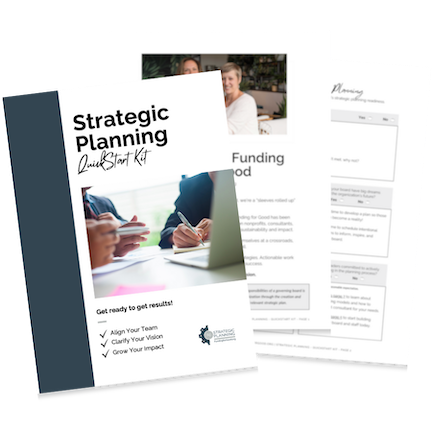Is your mostly volunteer-run nonprofit ready to take the leap and hire its first executive staff member? If so, then you’re about to join the ranks of nonprofit startups taking a critical step toward long-term growth, sustainability, and capacity building. For your board of directors, it also means making the transition from a working board vs governing board.
While most successful nonprofits go through this phase at some point, it still represents a monumental shift for your organization. Whether you’re a volunteer, a board member, or a part-time staffer holding down the fort, there are a few basics that can help you navigate the process.
The Valuable Role of Small Nonprofits
While the nonprofit sector and donors frequently celebrate the largest institutions, small organizations are often the backbone of our communities.
According to the latest data available, in 2016 “small organizations composed the majority of public charities.” Further, 66.6% of registered, tax-filing nonprofits reported income and expenditures below $500,000 per year.
With small organizations in particular, much of the core work is done by volunteers. The Urban Institute’s most recent Nonprofit Sector Brief reports that:
An estimated 25.1 percent of US adults volunteered in 2017, contributing an estimated 8.8 billion hours. This is a 1.6 percent increase from 2016. The value of these hours is approximately $195.0 billion.
Unlike in the private sector, nonprofit boards are also generally volunteer positions. For new and small nonprofits without executive staff, this means volunteers shoulder the lion’s share of work. As an organization’s programming grows, this can quickly create outsized pressure on board members and other volunteers. It’s then up to the board to make the decision about whether and when to hire an organization’s first Executive Director.
Working Board vs Governing Board
In a nonprofit board governance model, the board of directors is generally responsible for establishing organizational direction, providing organizational oversight, and ensuring the organization has the resources needed to fulfill its mission. However, the level of hands-on, day-to-day “oversight” the board provides depends on whether it’s a working board vs governing board.
How can you tell the difference between a working board and a governing board?
The moment when a board of directors decides to hire an organization’s first paid leadership position—often an Executive Director—is the same moment the transition from a working board to a governing board begins.
What is a working board of directors?
In addition to traditional governance responsibilities, a working board of directors has operational responsibilities. This means board members are responsible for not only setting organizational direction but also carrying it out.
In a working board, there may be little distinction in roles between what a staff or board member would traditionally do. Board members may lead programs, manage day-to-day logistics, and directly manage non-executive staff members (such as a volunteer coordinator or office coordinator).
What is a governing board of directors?
Compared to a working board, a governing board of directors is mainly focused on governance. A governing board sets the direction for the organization and the staff carries it out, including regularly reporting back to the board on progress. The role of a governing board is to provide the oversight, accountability, and checks and balances that ensure a nonprofit reaches its goals and remains sustainable.
Knowing when it’s time to grow
There are no set metrics for when it’s time for a nonprofit to hire their first executive staff. But there are indicators. For example:
- Are your organization’s services in such demand that your board, volunteers, or contractors can’t keep up?
- Do you have opportunities for increased funding, but not enough hands to fulfill deliverables?
- Are community members and partner organizations asking you to expand your services into new areas?
- Do you have a strong base of community and donor support, but not enough time to put it to use?
If your answer is yes to any of these, it’s time to consider making the transition.
Challenges When Transitioning from a Working Board to a Governing Board
Many startup nonprofits begin with a working board and eventually evolve to a governing board. This shift transfers day-to-day responsibilities for the organization’s work from the volunteer board to paid staff. While less responsibility sounds great in theory, it also requires that board members learn to “let go.”
Letting go isn’t always easy
The dedicated core of volunteers that has been working tirelessly on a shoestring budget will have to suddenly hand over the “management reins.” Though the board still retains oversight, staff will need space to carry out the work in their own way. Operations and systems may shift. Program approaches will adjust.
It’s like when a houseguest offers to load your dishwasher. Sure, everything is in the dishwasher, but not the “special way” that you’ve perfected. The silverware is upside down. The cups are on the wrong side. The bowls aren’t organized efficiently. But at the end of the day, the dishes still get clean.
Planning for financial pressures
Bringing on a full-time executive staff member also adds financial pressure to the organization. With salaried staff, you can’t simply hire and fire people month to month based on cash flow. You need a plan for how the organization will consistently make payroll. Before you can hire an Executive Director, you’ll need several months of operating expenses in the bank.
Managing executive staff
One of a nonprofit board’s main responsibilities is hiring, managing, and evaluating the Executive Director. That means you’ll need to set baseline policies for areas like pay and benefits, which ultimately impacts staff turnover and retention long-term. If this is your organization’s first management hire, you’ll also be setting the tone for your nonprofit’s management culture.
In short, even as the working board is letting go of day-to-day responsibilities, the governing board is taking on new and equally important roles. If you’re looking to make the transition, Funding for Good’s training, Transitioning from a Working to a Governing Board, is the perfect place to start.



